For the 2025 school year, there are 4 public schools serving 811 students in Bass Lake Joint Union Elementary School District. This district's average testing ranking is 5/10, which is in the bottom 50% of public schools in California.
Public Schools in Bass Lake Joint Union Elementary School District have an average math proficiency score of 25% (versus the California public school average of 33%), and reading proficiency score of 37% (versus the 47% statewide average).
Minority enrollment is 35% of the student body (majority Hispanic), which is less than the California public school average of 80% (majority Hispanic).
Overview
This School District
This State (CA)
# Schools
4 Schools
10,369 Schools
# Students
811 Students
5,826,838 Students
# Teachers
43 Teachers
268,018 Teachers
Student : Teacher Ratio
19:1
19:1
District Rank
Bass Lake Joint Union Elementary School District, which is ranked #1162 of all 1,925 school districts in California (based off of combined math and reading proficiency testing data) for the 2021-2022 school year.
Overall District Rank
#1155 out of 1941 school districts
(Bottom 50%)
(Bottom 50%)
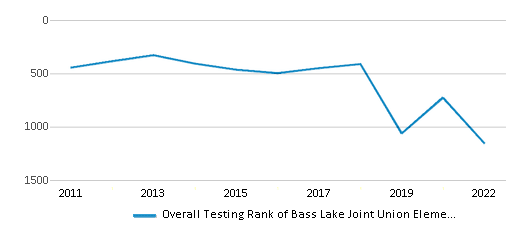
Math Test Scores (% Proficient)
25%
33%
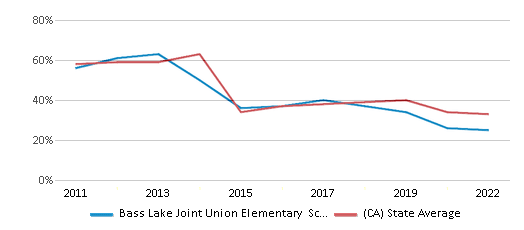
Reading/Language Arts Test Scores (% Proficient)
36%
47%
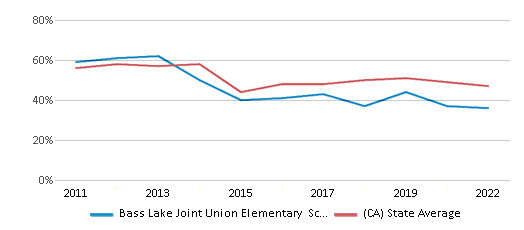
Science Test Scores (% Proficient)
20-24%
29%
Students by Ethnicity:
Diversity Score
0.52
0.63
# American Indian Students
25 Students
25,796 Students
% American Indian Students
3%
1%
# Asian Students
15 Students
705,807 Students
% Asian Students
2%
12%
# Hispanic Students
205 Students
3,264,561 Students
% Hispanic Students
25%
56%
# Black Students
1 Student
286,112 Students
% Black Students
n/a
5%
# White Students
525 Students
1,178,558 Students
% White Students
65%
20%
# Hawaiian Students
n/a
23,731 Students
% Hawaiian Students
n/a
n/a
# Two or more races Students
40 Students
333,755 Students
% of Two or more races Students
5%
6%
Students by Grade:
# Students in PK Grade:
-
83
# Students in K Grade:
77
522,456
# Students in 1st Grade:
76
396,605
# Students in 2nd Grade:
106
414,466
# Students in 3rd Grade:
73
416,628
# Students in 4th Grade:
90
426,361
# Students in 5th Grade:
93
430,587
# Students in 6th Grade:
93
432,997
# Students in 7th Grade:
107
439,621
# Students in 8th Grade:
96
441,777
# Students in 9th Grade:
-
466,534
# Students in 10th Grade:
-
476,585
# Students in 11th Grade:
-
469,511
# Students in 12th Grade:
-
492,627
# Ungraded Students:
-
-
District Revenue and Spending
The revenue/student of $15,593 in this school district is less than the state median of $19,974. The school district revenue/student has stayed relatively flat over four school years.
The school district's spending/student of $15,714 is less than the state median of $18,396. The school district spending/student has stayed relatively flat over four school years.
Total Revenue
$13 MM
$116,387 MM

Spending
$13 MM
$107,188 MM
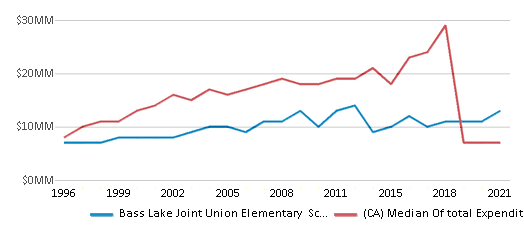
Revenue / Student
$15,593
$19,974

Spending / Student
$15,714
$18,396
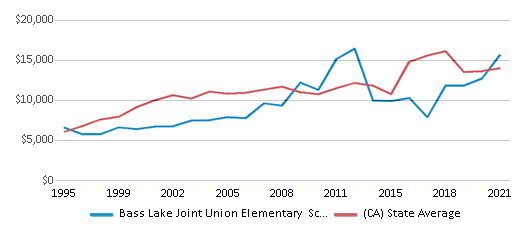
Best Bass Lake Joint Union Elementary School District Public Schools (2025)
School
(Math and Reading Proficiency)
(Math and Reading Proficiency)
Location
Grades
Students
Rank: #11.
Fresno Flats Community Day
Alternative School
(Math: <50% | Reading: <50% )
Rank:
Rank:
7/
Top 50%10
43109 Highway 49
Ahwahnee, CA 93601
(559) 642-1555
Ahwahnee, CA 93601
(559) 642-1555
Grades: 4-8
| 2 students
Rank: #22.
Oakhurst Elementary School
(Math: 30-34% | Reading: 40-44%)
Rank:
Rank:
6/
Top 50%10
49495 Road 427
Oakhurst, CA 93644
(559) 642-1555
Oakhurst, CA 93644
(559) 642-1555
Grades: K-5
| 347 students
Rank: #33.
Wasuma Elementary School
(Math: 25-29% | Reading: 35-39%)
Rank:
Rank:
5/
Bottom 50%10
43109 Hwy. 49
Ahwahnee, CA 93601
(559) 642-1585
Ahwahnee, CA 93601
(559) 642-1585
Grades: K-8
| 271 students
Rank: #44.
Oak Creek Intermediate
(Math: 15-19% | Reading: 30-34%)
Rank:
Rank:
3/
Bottom 50%10
40094 Indian Springs Rd.
Oakhurst, CA 93644
(559) 642-1555
Oakhurst, CA 93644
(559) 642-1555
Grades: 6-8
| 191 students
Frequently Asked Questions
How many schools belong to Bass Lake Joint Union Elementary School District?
Bass Lake Joint Union Elementary School District manages 4 public schools serving 811 students.
What is the rank of Bass Lake Joint Union Elementary School District?
Bass Lake Joint Union Elementary School District is ranked #1162 out of 1,925 school districts in California (bottom 50%) based off of combined math and reading proficiency testing data for the 2021-2022 school year.
What is the racial composition of students in Bass Lake Joint Union Elementary School District?
65% of Bass Lake Joint Union Elementary School District students are White, 25% of students are Hispanic, 5% of students are Two or more races, 3% of students are American Indian, and 2% of students are Asian.
What is the student/teacher ratio of Bass Lake Joint Union Elementary School District?
Bass Lake Joint Union Elementary School District has a student/teacher ratio of 19:1, which is lower than the California state average of 22:1.
What is Bass Lake Joint Union Elementary School District's spending/student ratio?
The school district's spending/student of $15,714 is less than the state median of $18,396. The school district spending/student has stayed relatively flat over four school years.
Recent Articles

Year-Round Or Traditional Schedule?
Which is more appropriate for your child? A year-round attendance schedule or traditional schedule? We look at the pros and cons.

Why You Should Encourage Your Child to Join a Sports Team
Participating in team sports has a great many benefits for children, there is no doubt. In this article you will learn what those benefits are.

White Students are Now the Minority in U.S. Public Schools
Increasing birth rates among immigrant families from Asia and Central and South America, combined with lower birth rates among white families, means that for the first time in history, public school students in the United States are majority-minority. This shift in demographics poses difficulties for schools as they work to accommodate children of varying language abilities and socio-economic backgrounds.





